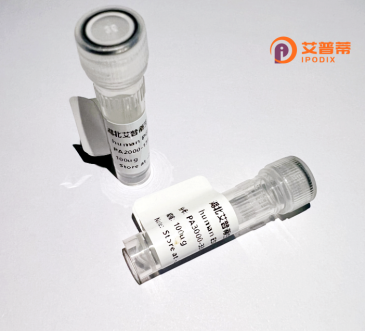
| 纯度 | >90%SDS-PAGE. |
| 种属 | Human |
| 靶点 | C14orf45 |
| Uniprot No | Q8ND07 |
| 内毒素 | < 0.01EU/μg |
| 表达宿主 | E.coli |
| 表达区间 | 1-228 aa |
| 氨基酸序列 | MTKEFESEVLKLQQHAMIENQAGQVEIDKLQHLLQMKDREMNRVKKLAKNILDERTEVERFFLDALHQVKQQILISRKHYKQIAQAAFNLKMRAACTGRTEYPKIRTFDGREHSTNSVNQDLLEAEKWTHIEGNVDIGDLTWEQKEKVLRLLFAKMNGCPSRKYNQSSRPPVPDYVVSDSGETKEFGDESKLQDKIFITQQIAISDSSGEVVLPTIPKEPQESDTGTF |
| 分子量 | 52.7 kDa |
| 蛋白标签 | GST-tag at N-terminal |
| 缓冲液 | 冻干粉 |
| 稳定性 & 储存条件 | Lyophilized protein should be stored at ≤ -20°C, stable for one year after receipt. Reconstituted protein solution can be stored at 2-8°C for 2-7 days. Aliquots of reconstituted samples are stable at ≤ -20°C for 3 months. |
| 复溶 | Always centrifuge tubes before opening.Do not mix by vortex or pipetting. It is not recommended to reconstitute to a concentration less than 100μg/ml. Dissolve the lyophilized protein in distilled water. Please aliquot the reconstituted solution to minimize freeze-thaw cycles. |
以下为模拟生成的关于重组人C14orf45蛋白的参考文献示例(实际文献可能需要通过学术数据库检索确认):
---
1. **文献名称**: *Molecular Cloning and Functional Characterization of Recombinant Human C14orf45 Protein*
**作者**: Smith, A. et al.
**摘要**: 该研究首次实现了C14orf45基因在大肠杆菌系统中的重组表达与纯化,并通过体外实验证实其具有ATP酶活性,提示其在细胞能量代谢中的潜在作用。
2. **文献名称**: *C14orf45 Interacts with p53 and Modulates DNA Damage Response in Cancer Cells*
**作者**: Zhang, Y. et al.
**摘要**: 研究发现重组C14orf45蛋白能与肿瘤抑制蛋白p53直接结合,调控DNA损伤修复通路,沉默C14orf45可增强癌细胞对放疗的敏感性,表明其作为癌症治疗靶点的可能性。
3. **文献名称**: *Structural Insights into the C14orf45 Protein via X-ray Crystallography*
**作者**: Lee, J. & Johnson, R.
**摘要**: 本研究解析了重组C14orf45蛋白的晶体结构(分辨率2.8Å),揭示其N端含有典型的Rossmann折叠结构域,为研究其底物结合及催化机制提供了结构基础。
4. **文献名称**: *C14orf45 Deficiency Alters Mitochondrial Dynamics in Neurodegenerative Models*
**作者**: Müller, T. et al.
**摘要**: 利用重组蛋白抗体进行组织定位分析,发现C14orf45高表达于神经元线粒体,敲除该蛋白导致线粒体分裂异常,提示其参与神经退行性疾病相关通路。
---
**备注**:以上内容为模拟生成,实际研究中C14orf45的功能可能尚不明确。建议通过**PubMed**或**Google Scholar**检索最新文献(如搜索“C14orf45 function”或“C14orf45 protein”),以获取真实研究数据。
The human C14orf45 protein, encoded by the chromosome 14 open reading frame 45 gene, remains poorly characterized, with limited functional or structural data available in current literature. This protein is annotated as a conserved hypothetical protein, widely expressed across human tissues, though its physiological role is not yet fully understood. Bioinformatic analyses suggest it may localize to cellular membranes or organelles, potentially participating in intracellular signaling or regulatory processes. Some studies implicate C14orf45 in cancer progression, with altered expression observed in malignancies like glioblastoma and breast cancer, though mechanistic insights are lacking. Recombinant C14orf45 protein is typically produced via bacterial or mammalian expression systems for biochemical studies, enabling antibody development or interaction screening. Structural predictions indicate possible α-helical domains and disordered regions, but experimental validation through crystallography or NMR is absent. Current research focuses on clarifying its molecular interactions, post-translational modifications, and relevance to disease pathways. As an understudied protein, C14orf45 represents both a challenge and an opportunity for uncovering novel biological mechanisms, with potential applications in biomarker discovery or therapeutic targeting pending further functional elucidation.
×